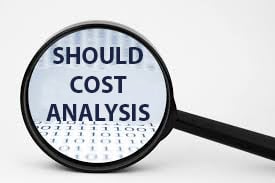13.02.2021
Why Should Cost Analysis?


Here are 4 reasons why virtually all best-in-class purchasers of electronic contract manufacturing services have moved away from strategic sourcing and now use some version of should cost analysis. There are lots of reasons this approach may not be best for you, but here are factors to consider.
1. Control Price Negotiations
The typical cost drivers for PCB assembly are Materials (60-80% of total cost), Labor (5-10%), Overhead (3-5%), and Profit (5-10%). Just by costing materials yourself (it is a fallacy to think contract manufacturers get better pricing than you; see How Electronic Components are Priced), you already know 60-80% of the typical PCBA cost. You can use simple labor models, for example 10 cents per placement for production as a starting point, and you have a should cost model covering 65-90%. Now when you sit down with suppliers to negotiate price, you can focus on what the supplier is asking for Overhead and Profit. After a few negotiations you will understand your market for Overhead and Profit, and then you will be in control of 100% of the cost.
2. Choose Your Partner Based on Value, Not Price
Strategic sourcing requires you to maintain a stable of suppliers who provide price feedback so you can determine who is 'most competitive.' Strategic sourcing guides you to place business with the least expensive supplier who has passed your supplier qualification standards; this approach de-emphasizes critical intangibles like responsiveness, quality performance, OTD performance, engineering contributions, and more.
The should cost approach frees you from reliance on quoting to determine your products' cost. Since you know what the product should cost, you can select the supplier you prefer to work with instead of the supplier who happened to submit the lowest bid, often due to natural variance in quoting.
3. Eliminate Price Negotiations
Best-in-class OEMs have eliminated negotiations on individual PCBA prices. They negotiate the labor and overhead, and agree to a fair profit margin. They negotiate component pricing direct with the suppliers, be it distribution or direct, and pass those BOM material prices to the contract manufacturer.
4. Focus on True Cost Reduction
This is the real power of should cost analysis. You are free from the adversarial relationship that is a structural assumption of strategic sourcing. Because you have prior agreement on the financial model, the OEM and CM teams can openly work together to drive out cost. This is particularly true of materials. Here are some more examples:
Guide cost reduction priorities—For existing items procured under strategic sourcing, you can compare the should cost model and focus efforts on items that exceed the should cost by 20% or more. Items that exceed should cost by 10-20% are potential candidates, and items exceeding by less than 10% are not likely to yield sufficient savings to justify the effort (depending on volume).
Clarify key cost drivers—You are now armed with detailed knowledge of the cost drivers for your products. Perhaps it is the PCB fab itself, perhaps it's a class of components that are used across a family of your products. Now that you know, you can focus on finding alternates or even redesigning to drive out cost.
A Real World Analogy
John is a strategic car buyer. He went to four dealers to get price quotes. He spent hours at each one, going through the steps each time. He took a test drive, met with the salesperson, asked for their "best price," got a price, got offers for underbody protection, paint protection, extra warranties, and all the other things that make each dealer different. John is experienced; he knows to say no. He gets to the manager, whose job is to close the deal. The closer puts on the pressure, but John perseveres and moves on to the next dealer, each time a little wiser. Eventually he makes a deal, hoping that by competing so many dealers against each other he's arrived at the lowest price.
Jane is a should cost car buyer. She went online and looked up the dealer's invoice price. She did some research on what kind of markup the market is bearing for the make and model she wants to buy. She does a little more work on the forums to see if there are any backdoor discounts going on that she should know about. Years ago she would then go into the dealer and negotiate the price she wanted to pay. Nowadays they know her, and she just calls and tells them the price and works out delivery.
Because Jane is a knowledgeable, informed buyer she saves herself the inefficiency of strategic buying and is much more satisfied with the experience because she is confident she got the right price.
The Next Step: NPI
Too often engineering teams lack the resources to accurately investigate the manufactured cost of products they are designing. With a should cost model in place, engineering and procurement can work together in near-real time to understand the manufactured should cost as the product goes through the design cycle. By identifying cost drivers early, engineering can make informed cost/benefit decisions, often redesigning to implement the desired circuit for lower cost. From a costing perspective, the new product can transition seamlessly from NPI to production release with volume pricing already modeled and understood.
Conclusion
Every company needs to evaluate what's best for their situation. Strategic sourcing is a tried-and-true methodology that is still the dominant approach. But we believe that over the next 3-5 years more and more mid-size OEMs will follow the lead of top-tier OEMs and base their procurements on should cost modeling [tweet quote] .
Further Reading
Online PCB Assembly Price Calculator
This post originally appeared on the DigiSource Blog


